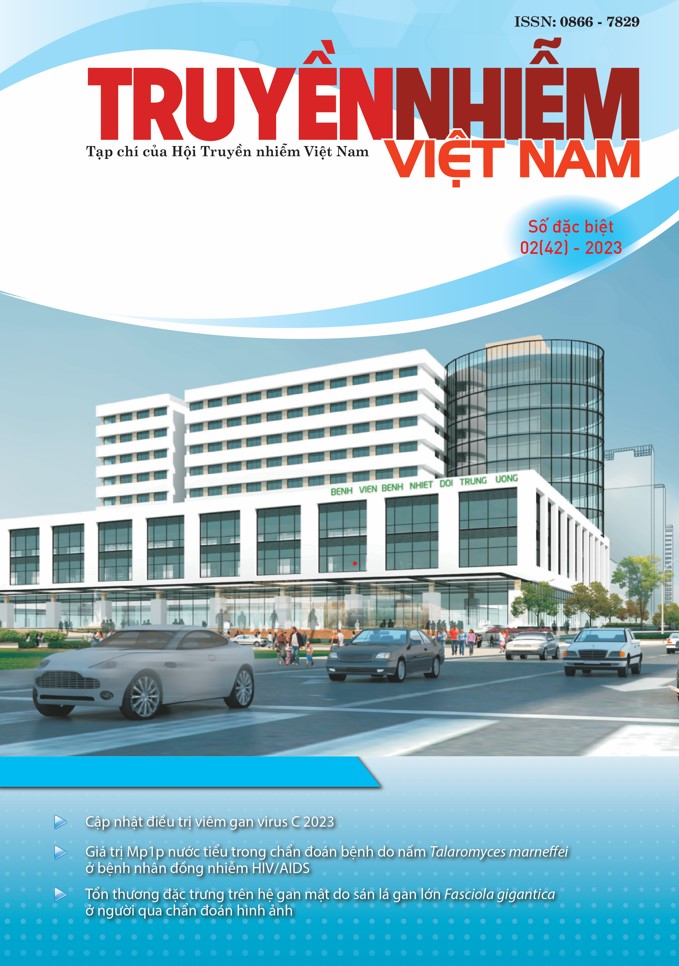RISK FACTORS OF RIFAMPICIN-RESISTANT TUBERCULOSIS IN THUA THIEN HUE
Main Article Content
Abstract
Objectives: 1. Describe the clinical and subclinical characteristics of patients with pulmonary tuberculosis resistant to rifampicin. 2. Some risk factors in patients with pulmonary tuberculosis resistant to rifampicin.
Subjects and methods: A cross-sectional descriptive study on 157 tuberculosis patients diagnosed by Xpert MTB/RIF test at the Department of Lung Diseases, Hue Central Hospital and Thua Thien Hue Lung Hospital from January 2021 to September 2022.
Results: Males accounted for the majority of the rifampicin-resistant pulmonary tuberculosis group (90.3%), average age: 48.19 ± 2,997, BMI ≤ 18.5 kg/m2 (61.3%), with history treated with anti-tuberculosis drugs (64.5%). Clinical features: fatigue (74.2%), anorexia (71%), weight loss (71%), persistent cough and expectoration (77.4%), shortness of breath (51.6%), chest pain (67.7%), hemoptysis (16.1%). Most rifampicin-resistant pulmonary tuberculosis had rales in the lungs (80.6%). Subclinical features: Sputum AFB test is usually positive (64.5%) with positivity levels of 1+ (45%), 2+ (30%), 3+ (20%). The extent of lesions according to ATS on straight chest radiographs is commonly found at level II (45.2%), level III (48.4%). The location of the lesion tends to be diffuse (51.6%). lesions: Infiltrative (96.8%), fibrous (51.6%), nodular (19.4%), cavernous (41.9%). There was an association between rifampicin-resistant pulmonary TB and a history of TB treatment (OR = 10.557, 95% CI: 3.263 - 34.150), rales in the lungs (OR = 4.159, 95% CI: 1.016 - 17.031), cavernous lesions (OR = 6.415, 95% CI: 1.819 - 22.624) and nodules (OR = 10.649, 95% CI: 1.438 - 78.846) on straight chest radiographs.
Conclusions: There is an association between rifampicin-resistant pulmonary tuberculosis and a history of TB treatment, with physical symptoms in the lungs, with cavity or nodular lesions on the chest radiograph.
Article Details
Keywords
Tuberculosis, MDR-TB, rifampicin
References
2. Lê Hữu Thọ (2014), "Nghiên cứu các đặc điểm chung và lâm sàng của bệnh lao kháng thuốc và không kháng thuốc tại Khánh Hòa", Tạp chí Y học Việt Nam, 7(1), tr. 97-102.
3. Mai Văn Tuấn (2016), Sự đột biến kháng rifampicin và isoniazid của Mycobacterium Tuberculosis phân lập tại Bệnh viện Trung ương Huế, Luận án tiến sĩ chuyên ngành vi sinh y học, Trường Đại học Y Dược TP. Hồ Chí Minh.
4. Elmi O. S., Hasan H., Abdullah S., Jeab M. Z. M., Alwi Z. B., Naing, N. N. (2015), "Multidrug-resistant
tuberculosis and risk factors associated with its development: a retrospective study", The Journal of
Infection in Developing Countries, 9(10), pp. 1076-1085.
5. Flores-Treviño S., Rodríguez-Noriega E., Garza-González E., González-Díaz E., Esparza-Ahumada S., EscobedoSánchez R., et al. (2019), "Clinical predictors of drug-resistant tuberculosis in Mexico", PloS one, 14(8), pp. 1-9.
6. Hang N. T. L., Maeda S., Lien L. T., Thuong P. H., Hung N. V., Thuy T. B., et al. (2013), "Primary drugresistant tuberculosis in Hanoi, Viet Nam: present status and risk factors", PloS One, 8(8), pp. 1-9.
7. Kumar N. S., Priyashree R., Gopal K. V., Gadwalkar R. S. (2021), "Clinical profile and risk stratification
in multidrug-resistant tuberculosis (MDR-TB) and non-MDR-TB patients: A prospective study in a
tertiary care hospital", Journal of Medical and Scientific Research, 9(4), pp. 199-203.
8. Phuong N. T. M., Nhung N. V., Hoa N. B., Thuy H. T., Takarinda K. C., Tayler-Smith K., Harries, A. D.
(2016), "Management and treatment outcomes of patients enrolled in MDR-TB treatment in Viet Nam", Public Health Action, 6(1), pp. 25-31.
9. Pradipta I. S., Forsman L. D., Bruchfeld J., Hak E., Alffenaar J. W. (2018), "Risk factors of multidrug-resistant tuberculosis: A global systematic review and meta-analysis", Journal of Infection, 77(6), pp. 469-478
10. Xi Y., Zhang W., Qiao R. J., Tang J. (2022), "Risk factors for multidrug-resistant tuberculosis: A
worldwide systematic review and meta-analysis", PLoS ONE, 17(6), pp. 1-15.


